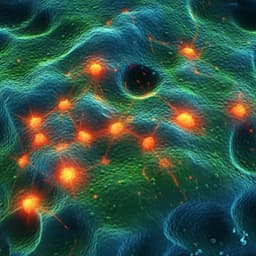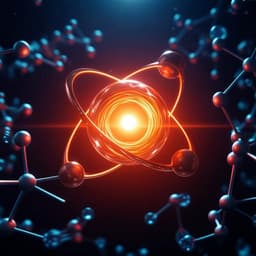
Chemistry
Highly active, ultra-low loading single-atom iron catalysts for catalytic transfer hydrogenation
Z. An, P. Yang, et al.
This groundbreaking research presents a single-atom iron catalyst that dramatically enhances catalytic transfer hydrogenation of furfural, showcasing performance that outstrips existing catalysts by up to four orders of magnitude. Conducted by a talented team including Zhidong An, Piaoping Yang, and many others, this study reveals the vital role of pyrrolic Fe(II)-PIN3 as the active site in this truly innovative process.
~3 min • Beginner • English
Introduction
The study addresses the challenge of designing highly active, selective, and noble-metal-free heterogeneous catalysts with well-defined active centers for catalytic transfer hydrogenation (CTH). Although single-atom (SA) catalysts can expose uniform active sites and enhance atom efficiency, identifying the true active centers in heterogeneous catalysts remains difficult due to site heterogeneity and characterization limitations. Biomass-derived furfural (FF) is a key platform molecule and a benchmark substrate for CTH to furfuryl alcohol (FA). Prior iron-based catalysts for FF CTH generally show low intrinsic activity and require harsh conditions, with typical TOFs below 10 h−1. This work aims to synthesize an ultra-low-loading SA Fe catalyst on ZIF-8 via saturated adsorption of Fe nitrate and pyrolysis, elucidate the active site structure, uncover the reaction mechanism, and achieve high activity and selectivity for FF CTH under mild conditions.
Literature Review
Recent advances in SA catalysts for biomass conversions have predominantly focused on noble metals (Ru, Pd, Pt) anchored on N-doped carbons or oxides, enabling superior activities and selectivities. Examples include Ru, Pd, Pt SAs on mesoporous N-doped carbon nanofibers for formic acid decomposition; Ru-SAs on graphitic carbon nitride for vanillin hydrogenation/hydrodeoxygenation; and chitosan-derived N-doped carbons with high TONs in lignocellulose fractionation. Pt SAs on TiO2 and defect-rich Nb2O5 have shown exceptional selectivity for C–O scission and MF production, respectively. Non-noble transition metal SA catalysts are attractive for cost and abundance: Co SAs on MoS2 basal plane S-vacancies show superior HDO of 4-methylphenol at low temperature; high-loading Ni SAs on N-doped carbons exhibit high hydrogenation activity and robustness; Ni–N4 sites on CNTs catalyze CTH of HMF with good TOFs using ethanol, where pyridinic N was proposed as the active center facilitating H desorption. For Fe-catalyzed CTH of FF, prior reports demonstrate moderate selectivity and conversion at 160 °C over many hours and generally low intrinsic activity, often complicated by heterogeneous iron phases and imprecise active site quantification. Conventional ZIF-8-derived Fe/Co SA synthesis relies on pore confinement with bulky precursors (e.g., acac, ferrocene) to obtain Fe(II)–N4 pyridinic sites; alternative routes and active site architectures remain underexplored.
Methodology
Catalyst synthesis: Ultra-low loading (<0.1 wt%) SA Fe catalysts were prepared by saturated adsorption of Fe(NO3)3 onto ZIF-8 followed by pyrolysis at 800 °C (Fe-ZIF-8-800). A comparative catalyst was prepared from MOF-5 (Fe-MOF-5-800), which yielded higher Fe loading (~5.73 wt%) and different structural features. A two-step adsorption route was also tested to tune Fe loading, yielding similar performance and single-atom dispersion at the same loading.
Characterization: Morphology and dispersion were probed by SEM, TEM, and HAADF-STEM with EDS elemental mapping, showing uniform lamellar structures (~160 nm) and even Fe dispersion in Fe-ZIF-8-800. XRD indicated amorphous carbon in ZIF-derived catalysts and ZnO and metallic Fe signatures in MOF-5-derived materials. Raman (ID/IG) suggested higher defect density in Fe-ZIF-8-800 than in Fe-MOF-5-800 and ZIF-8-800. XPS showed Zn binding energy shifts consistent with N-mediated charge transfer from Zn to Fe and N 1s components with significant pyrrolic N; complete loss of Zn and N occurred at 1000 °C pyrolysis. XANES/EXAFS at Fe and Zn K-edges revealed oxidized Fe, Fe–N bond lengths ~1.4 Å, no Fe–Fe or Zn–Zn aggregation in ZIF-derived materials (confirmed by wavelet transforms), and a Fe–N coordination number of ~3.7, consistent with a mixture of FeN3 and FeN4 environments. Zn–N coordination was ~3.9–4.1, similar in Fe-ZIF-8-800 and ZIF-8-800. Computed XANES using FDMNES indicated best agreement with porphyrin-like pyrrolic N-coordinated moieties: Fe(II)–N3C10 and Fe(II)–N4C12 for Fe sites and Zn(II)–N4C12 for Zn sites; pyridinic N models did not reproduce experimental edge/post-edge features.
Catalytic testing: CTH of FF to FA was conducted in isopropanol (IPA) solvent in a sealed glass tube. Typical conditions: FF 0.5 mmol, catalyst 50 mg, IPA 3 mL, 120 °C, 6 h (Fe/FF molar ratio for Fe-ZIF-8-800 ~0.13%). Performance at other temperatures (80–160 °C) and loadings were evaluated. TOFs were calculated under kinetic regime at low conversion (<20%). Isotopic labeling used 10% 2-propanol-d8 (and d6) in t-butanol at 120 °C for 3 h with MS analysis of FA products.
Computations and microkinetics: Spin-polarized DFT (VASP 5.4.1, optPBE-vdW, PAW, 400 eV cutoff) modeled periodic graphene-supported Fe(II)-pIN3 (Fe–N3C10), Fe(II)-pIN4 (Fe–N4C12), and Zn(II)-pIN4 (Zn–N4C12) sites (3×7 graphene supercells, 3×2×1 k-mesh). Transition states were located via NEB/dimer and confirmed by frequency analysis. Thermochemistry used Burcat database and pMuTT corrections; microkinetic modeling (Chemkin) incorporated pathways P1/P2 on Fe(II)-pIN4 and Zn(II)-pIN4 and P3 on Fe(II)-pIN3. XANES simulations used FDMNES with validated convolution parameters against standards.
Key Findings
- SA Fe on ZIF-8 at ultra-low loading (<0.1 wt%) exhibits exceptional CTH activity for FF to FA:
- At 120 °C, TOF = 1882 h−1 (measured at 5 min, ~20.5% conversion); FA selectivity 96.9% at 99.6% FF conversion in 6 h; up to 93.1% FA yield at 99.5% conversion in 1 h.
- At 80 °C, TOF ≈ 367 h−1; at 160 °C, 96.6% FA yield in 0.5 h at complete conversion.
- TOF is 2–4 orders of magnitude higher than reported Fe catalysts (which typically operate at 160–200 °C with TOF <10 h−1).
- Structure of active sites:
- EXAFS-derived Fe–N coordination number ≈3.7, indicating FeN3/FeN4 mixture; no Fe–Fe scattering in ZIF-derived catalyst; Zn–N CN ≈4.
- Computed/experimental XANES best match pyrrolic N-coordinated moieties: Fe(II)–N3C10 and Fe(II)–N4C12; Zn in Zn(II)–N4C12.
- Mechanism:
- Isotopic labeling (2-propanol-d8) gives 1 amu MS shift in FA, confirming intermolecular hydride transfer via an MPV-type mechanism.
- On rigid Fe(II)-pIN4 and Zn(II)-pIN4 sites, only non-typical MPV pathways (P1, P2) are viable, with energy spans ~1.2–1.4 eV and similar activities for Fe and Zn, inconsistent with experiments.
- On Fe(II)-pIN3, a typical MPV pathway (P3) operates: IPA binds Fe(II) and is deprotonated by a vicinal pyrrolic N; FF then coordinates to Fe(II) facilitated by protonation-induced weakening of Fe–N and out-of-plane relaxation of Fe; the rate-limiting α-hydride transfer via a six-membered transition state has an activation barrier of ~0.87 eV and defines the overall span, much lower than on pIN4 sites.
- Microkinetic simulations predict TOF on Fe(II)-pIN3 to exceed those on Fe(II)-pIN4 and Zn(II)-pIN4 by six orders of magnitude.
- Electronic/structural insight:
- Both Fe(II)-pIN3 and Fe(II)-pIN4 are Fe2+ by analysis of magnetic moments; higher activity of Fe(II)-pIN3 arises from three-coordinate, defect-anchored geometry enabling co-adsorption and a favorable crystal field upon forming a tetrahedral-like intermediate.
- Substrate scope and effects:
- Catalyst exhibits chemoselective CTH of -CHO without ring hydrogenation across several substrates; substrates with additional acidic -OH groups (e.g., HMF, phenolics) show suppressed activity correlated with lower pKa than IPA (hydrogen donor), attributed to competitive binding/quenching of active centers.
- Electron-withdrawing substituents (p-F, p-CF3) slightly reduce yields; p-Cl lowers selectivity more; bulky p-tert-butyl strongly suppresses reactivity (sterics). Unsaturated aldehydes (cinnamaldehyde) show better reactivity than some saturated analogs.
- Stability/recyclability:
- Activity decreases after the 2nd reuse while FA selectivity remains high; EXAFS shows Fe–N CN increases from 3.7 (fresh) to 4.6 (spent). Reintroduction of trace Fe precursor (0.01 wt%) and re-pyrolysis restores full activity, underscoring the indispensability of trace SA Fe.
Discussion
The work demonstrates that a noble-metal-free SA Fe catalyst with ultrasparse loading can surpass prior Fe catalysts in CTH activity under mild conditions. Mechanistic experiments and multiscale modeling converge on a typical MPV mechanism involving intermolecular hydride transfer, with the active center identified as a defect-anchored pyrrolic Fe(II)–N3 site. The key to the high activity is structural flexibility: protonation-induced weakening of one Fe–N bond allows the Fe center to move out of the plane and simultaneously coordinate the alcohol and carbonyl substrates, lowering the hydride transfer barrier. In contrast, more rigid Fe(II)/Zn(II)–N4 sites cannot co-adsorb both reactants effectively, limiting them to higher-energy non-typical MPV pathways and leading to significantly lower activity. Substrate studies reveal that acidic -OH groups can poison or compete for the active site, correlating reactivity with pKa and providing design rules for substrate/catalyst pairing. The findings address the original hypothesis that engineering the coordination environment and flexibility of SA Fe centers can unlock high CTH performance without noble metals, highlighting defect-enabled geometric adaptability as a previously underappreciated determinant of heterogeneous catalytic activity.
Conclusion
This study introduces an ultra-low loading single-atom Fe catalyst derived from ZIF-8 via saturated adsorption of Fe nitrate and pyrolysis that achieves record-high TOF for furfural CTH to furfuryl alcohol under mild conditions, rivaling state-of-the-art catalysts. Combined spectroscopic, isotopic, computational, and kinetic analyses identify a pyrrolic Fe(II)–N3 active site as responsible for the high activity via a typical MPV pathway enabled by site flexibility and defect anchoring. The catalyst exhibits broad chemoselectivity yet shows reduced activity for substrates with more acidic -OH groups than the hydrogen donor, rationalized by pKa correlations and competitive binding. These insights establish structural flexibility of single-atom active centers as a critical design lever in heterogeneous catalysis and pave the way for developing noble-metal-free SACs for transfer hydrogenation and related transformations. Future work could expand to other supports and defect chemistries to tune Fe coordination, improve recyclability and site stability, broaden substrate scope, and generalize the flexible-site design principle to other base-metal SACs and reactions.
Limitations
- Catalyst deactivation: Activity decreases after the second recycle despite preserved selectivity; spent catalysts show increased Fe–N coordination (from ~3.7 to ~4.6), indicative of site evolution/rigidification. Restoration requires adding trace Fe and re-pyrolysis.
- Substrate scope constraints: Strongly acidic -OH-containing substrates (e.g., phenolics, HMF) inhibit CTH via competitive binding/protonation of active centers; sterically bulky substituents also reduce activity.
- Site heterogeneity: Although evidence supports FeN3 as the dominant active site, EXAFS indicates a mixture of FeN3/FeN4 environments, and ultralow Fe loading complicates direct spectroscopic quantification (e.g., weak Fe XPS signals).
- Generalizability: The demonstrated flexibility and activity are tied to defect-anchored pyrrolic coordination; translation to different supports, metals, or reaction conditions may require tailored synthesis/defect engineering.
Related Publications
Explore these studies to deepen your understanding of the subject.







